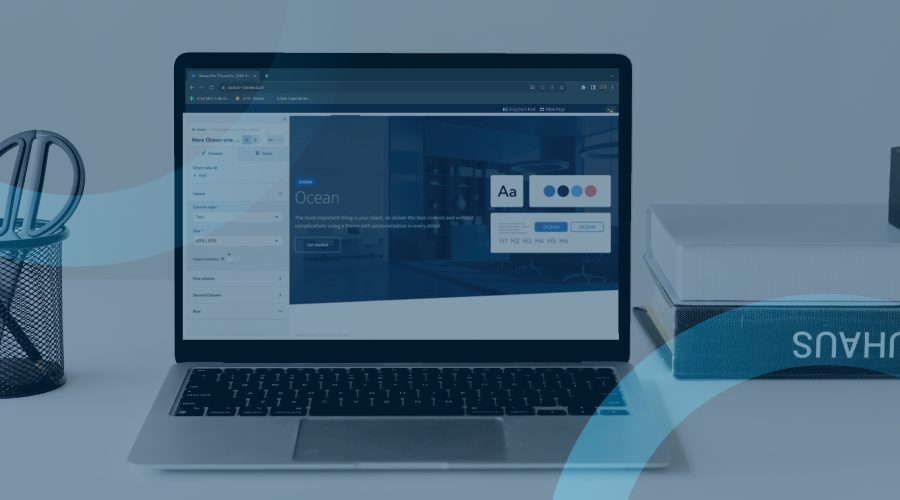A web project can have a challenging start if you're not clear on all that it entails. When it comes to choosing your website, which will be the face of your business, it's crucial to design something that matches the stature of your brand, and using themes to simplify the task is a great option.
There are both free and paid themes, and it's essential to understand the differences between them to choose the one that best suits your current needs.
In this article, we'll share with you what website themes are, how they can help improve your online presence, and the advantages of different types.
So, are you ready to dive into the world of website themes and discover the best option for your project?
What are Website Themes?
A theme can be thought of as a template that brings together a set of designs to customize and build your website from scratch in a simple way.
They aim to streamline the integration of elements on a website to provide an optimal experience for users who visit a web page.
Themes can vary in terms of design and functionality, ranging from simple and minimalist to complex ones with pre-installed features like shopping carts, contact forms, and more.
There are two main types of themes: free and paid.
Free Themes
These are an option to consider if you're just starting out and have a limited budget to invest in a premium theme.
This type of theme offers the opportunity to launch a fully functional website without investing significant amounts of money into design. Various platforms, such as HubSpot, WordPress, among others, offer these themes.
A positive aspect of free themes is their accessibility, as they have a wide range of available themes for users to choose from.
Additionally, this type allows you to get familiar with working with themes and templates, as you can experiment with different styles and functions to understand how they work for businesses.
However, free themes also have their disadvantages. They cannot offer the same level of customization as a paid theme, limiting your ability to make your site stand out and tailor it to your specific needs.
Paid Themes
Unlike free themes, paid themes, also known as premium themes, are templates that come with a price tag.
The cost can vary significantly, from a few dollars to hundreds, depending on the quality and features you're looking for.
These themes typically offer a broader range of design options and additional functionalities compared to the former. Moreover, they are usually better optimized for SEO, which can help improve your website's organic search rankings.
However, one major drawback of paid themes is that they require a significant upfront investment, which might not be feasible for a business that's just starting out.
Main Differences Between Free and Paid Themes
Now that we've individually explored free and paid themes, let's delve into the key differences between the two.
1. Customization and Functionality
Paid themes usually offer a higher degree of customization compared to free themes. They come with a wide range of features and additional functionalities that allow users to create something more comprehensive and professional.
2. Customer Support
Another important difference is the level of customer support. Premium themes often come with dedicated support services to address any issues users may encounter while using them.
Free themes, on the other hand, might lack this support option, potentially making the web development process more challenging.
3. SEO Optimization
Paid themes are usually designed to meet SEO needs to enhance search engine presence. This can increase website visits and subsequently sales, unlike free themes, which lack the extensive design range to favor this aspect.
4. Price
One of the most noticeable differences is, of course, the price. Premium themes require an initial investment, while free ones do not.
However, if you want to avoid limitations when implementing functionalities, consider investing in a theme that caters to all your needs.
5. Updates and Maintenance
As one can imagine, paid themes come with the added benefit of constant maintenance and updates to stay up to date.
While free themes also have developer support, it's less frequent, and errors that slow down the work can arise.
6. Design Quality
Last but not least, design quality can be a distinguishing factor between free and paid themes.
Developers of premium themes often invest more time and resources into creating attractive and modern designs, whereas free themes might have a more basic or generic design.
HubSpot's Ocean Theme
One of the best options on the market is HubSpot's Ocean Theme, a solution created by Media Source. It comes in both a free and a paid version, with the Pro version being the star.
Compared to free themes, Ocean Theme offers:
- High website performance
- 100% code-free
- Fully scalable
- Generates more leads and boosts conversions
- Over 40 pre-built templates
- Saves thousands of dollars on design and development
By using Ocean Theme, you can say goodbye to the tedious design and programming processes and create a tailored website that meets all your needs.
Additionally, it offers styling options to let your creativity shine through with modules, sections, and templates. All of this while ensuring your design is visualized in a mobile version.
Conclusion
Choosing between a free theme and a paid theme, such as Ocean Theme, largely depends on your specific needs, budget, and technical skills.
If you're starting out and have a limited web design budget, a free theme might suffice. However, these options often have limitations in terms of customization, features, and technical support.
On the other hand, if you're looking for advanced features, greater customization, optimized performance, and reliable technical support, a paid theme can be a valuable investment.
For instance, Ocean Theme provides a variety of customizable templates and modules, a drag-and-drop interface, and advanced styling and design options.
Ultimately, selecting the perfect theme for your website should be a strategic decision that aligns with your business goals and user needs.

.png?width=319&height=267&name=gtmetrix_2023%20(1).png)




